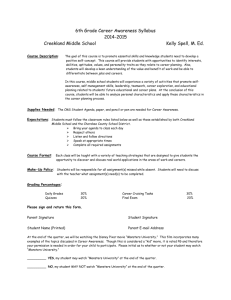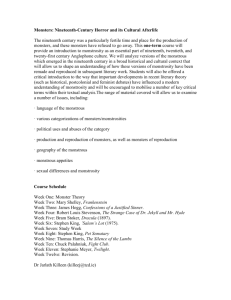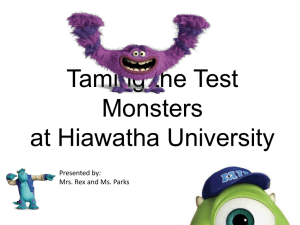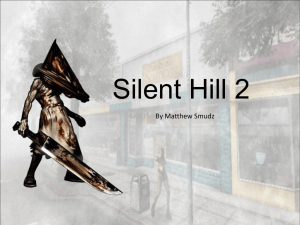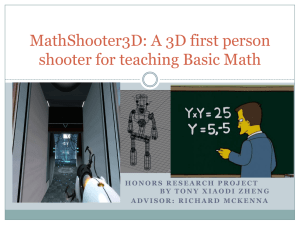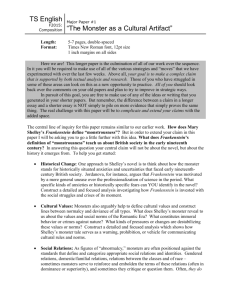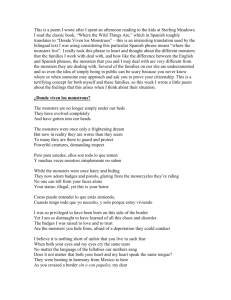Our Monsters, Ourselves
advertisement
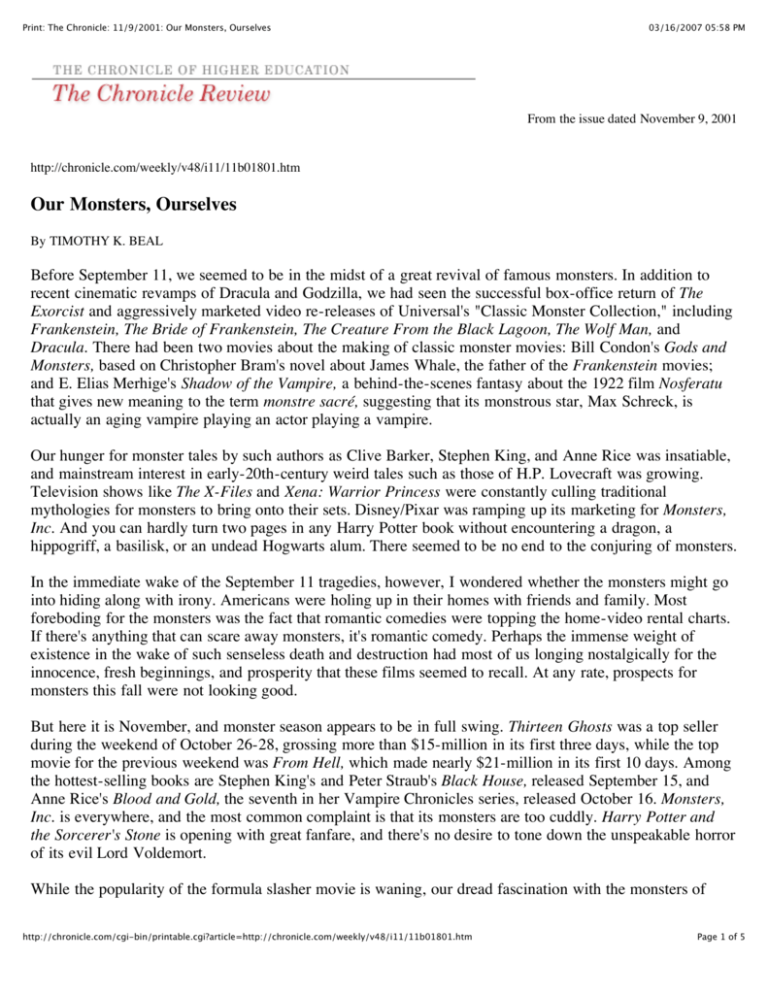
Print: The Chronicle: 11/9/2001: Our Monsters, Ourselves 03/16/2007 05:58 PM From the issue dated November 9, 2001 http://chronicle.com/weekly/v48/i11/11b01801.htm Our Monsters, Ourselves By TIMOTHY K. BEAL Before September 11, we seemed to be in the midst of a great revival of famous monsters. In addition to recent cinematic revamps of Dracula and Godzilla, we had seen the successful box-office return of The Exorcist and aggressively marketed video re-releases of Universal's "Classic Monster Collection," including Frankenstein, The Bride of Frankenstein, The Creature From the Black Lagoon, The Wolf Man, and Dracula. There had been two movies about the making of classic monster movies: Bill Condon's Gods and Monsters, based on Christopher Bram's novel about James Whale, the father of the Frankenstein movies; and E. Elias Merhige's Shadow of the Vampire, a behind-the-scenes fantasy about the 1922 film Nosferatu that gives new meaning to the term monstre sacré, suggesting that its monstrous star, Max Schreck, is actually an aging vampire playing an actor playing a vampire. Our hunger for monster tales by such authors as Clive Barker, Stephen King, and Anne Rice was insatiable, and mainstream interest in early-20th-century weird tales such as those of H.P. Lovecraft was growing. Television shows like The X-Files and Xena: Warrior Princess were constantly culling traditional mythologies for monsters to bring onto their sets. Disney/Pixar was ramping up its marketing for Monsters, Inc. And you can hardly turn two pages in any Harry Potter book without encountering a dragon, a hippogriff, a basilisk, or an undead Hogwarts alum. There seemed to be no end to the conjuring of monsters. In the immediate wake of the September 11 tragedies, however, I wondered whether the monsters might go into hiding along with irony. Americans were holing up in their homes with friends and family. Most foreboding for the monsters was the fact that romantic comedies were topping the home-video rental charts. If there's anything that can scare away monsters, it's romantic comedy. Perhaps the immense weight of existence in the wake of such senseless death and destruction had most of us longing nostalgically for the innocence, fresh beginnings, and prosperity that these films seemed to recall. At any rate, prospects for monsters this fall were not looking good. But here it is November, and monster season appears to be in full swing. Thirteen Ghosts was a top seller during the weekend of October 26-28, grossing more than $15-million in its first three days, while the top movie for the previous weekend was From Hell, which made nearly $21-million in its first 10 days. Among the hottest-selling books are Stephen King's and Peter Straub's Black House, released September 15, and Anne Rice's Blood and Gold, the seventh in her Vampire Chronicles series, released October 16. Monsters, Inc. is everywhere, and the most common complaint is that its monsters are too cuddly. Harry Potter and the Sorcerer's Stone is opening with great fanfare, and there's no desire to tone down the unspeakable horror of its evil Lord Voldemort. While the popularity of the formula slasher movie is waning, our dread fascination with the monsters of http://chronicle.com/cgi-bin/printable.cgi?article=http://chronicle.com/weekly/v48/i11/11b01801.htm Page 1 of 5 Print: The Chronicle: 11/9/2001: Our Monsters, Ourselves 03/16/2007 05:58 PM supernatural horror will not relent. The reawakening of the monstrous continues. These days more than ever it seems you can't keep a good monster down. Perhaps not just vampires but all monsters are undead. No matter how many times we exorcize them, blow them to bits, or banish them to outer space, they keep coming back for more. Our monsters are always trying to show us something, if we would only pay attention. The word "monster" itself goes back to the Latin verb monstrare, "show" or "reveal." Monsters are inherently demonstrative. So what are they trying to show us now? Perhaps they are simply showing us how much we want to get back to the usual routine, to follow the president's advice and carry on with our lives as we normally would. Eat in restaurants. Travel in airplanes. Go to Disney World. And around Halloween time, watch scary movies and read scary books. Because that's what we normally do during this time of year. On another level, our continued interest in monsters undoubtedly reveals our desire to find a scapegoat for our fears and anxieties. Monsters put a face on our otherwise vague sense of impending doom. In this light, the typical Hollywood monster movie serves as a vehicle for a public rite of exorcism in which our looming sense of unease is projected in the form of a monster and then blown away. Although there will be some collateral damage before the battle is over, in the end the monster will be vanquished and the nation will be safe once again. In this way such monster movies literally scare the hell out of us. And in an insecure time such as this one, they give us a sense of closure. For the time being, anyway. But our monsters are more than seasonal consumer items, and more than scapegoats for our menacing unease. Our monsters reveal the edges of secure knowledge, the limits of conscious reach, the boundaries of human expansion. Think of those ancient maps on which unknown territories were indicated by images of fantastic monsters accompanied by warnings, the most famous being the Lenox Globe's hic sunt dracones, "here be dragons." The monstrous figures on those ancient maps occupied the edges of unknowing, simultaneously forbidding and enticing would-be adventurers to draw near. So too when it comes to the monsters that lurk on the edges of our personal and cultural landscapes. They mark our own unknown territories, the places where our well-established sense of the order of things touches chaos, where our toes curl over the edge of the abyss. We meet monsters at those points where our boundlessly confident, ever-expanding consciousness shudders and freezes in its tracks. Last spring I taught a new course called "Religion and Horror." The basic idea was to see what we could learn about the religious traditions of Judaism and Christianity by approaching them through their monsters (the biblical Leviathan and Behemoth, for example), and to see what we could learn about the monsters of contemporary horror by looking into their religious backgrounds. You might say that we were exploring religion as horror and horror as religion. Horror as religion? Granted, most of us don't go to monster movies or read Gothic horror novels to get religion. Nonetheless, the popular culture of horror often provides an alternative venue for religious reflection. Supernatural horror literature and movies frequently explore how gods and monsters relate -change places, even -- in culture and in our imaginations. Throughout Mary Shelley's novel and James Whale's movies, for example, Frankenstein's monster pushes the question, Who is more monstrous, the Creature who must live through this vale of tears or the Creator who put him here? And films like Nosferatu and Shadow of the Vampire present the monster as a revelation of dreadful yet fascinating religious http://chronicle.com/cgi-bin/printable.cgi?article=http://chronicle.com/weekly/v48/i11/11b01801.htm Page 2 of 5 Print: The Chronicle: 11/9/2001: Our Monsters, Ourselves 03/16/2007 05:58 PM otherness, a radically heterodox image of the divine. Whereas the Frankenstein stories ask whether God is a monster, Nosferatu and Shadow ask whether the monster is a god. That there is a slippery slope between gods and monsters is not a new idea. As personifications of radical otherness, the monsters of supernatural horror are often identified with the divine, especially with its more dreadful, maleficent aspects. And the experience of horror in the face of the monstrous is akin in many respects to religious experience: Both are often represented as encounters with mysterious otherness that elicit a vertigo-like combination of dread and fascination -- a feeling captured in the older spelling of "aweful," which retains its sense of awe. Indeed, in his classic 1917 essay on religious experience, The Idea of the Holy (Das Heilige), Rudolph Otto went so far as to describe the monstrous as an apt expression of the holy in all its aspects of overwhelming awe, wonder, and dread -- what he called the mysterium tremendum. You might say that the monstrous, for Otto, was a kind of monstrum tremendum, an aweful envoy of the holy. Many of the students in "Religion and Horror" were aficionados of the monstrous as much as they were scholars of religion. And for them, the idea of horror as religion was not new. In fact, their critical engagements of horror culture often seemed to be driven by religious questions and interests that were not being entertained in mainstream religious venues. Sometimes, as in discussions of Bram Stoker's Dracula or Rice's Interview With the Vampire, the questions they raised would have been just as appropriate in a theology course. If everything comes from God, is God not the author of evil as well as good, chaos as well as order? Is immortality always desirable? Is redemption always possible? Are some, like Dracula or Grendel, chosen for curse and others for blessing? If so, might we sympathize with these monsters as tragic figures, cursed to live within the created order as abominations against it? Although such questions are indeed staples of Jewish and Christian biblical tradition (think of Cain, Job, and Judas), horror films and literature often draw attention to them in ways that undermine their traditional answers. Horror tends to amplify theological problems over theological solutions. Drawing from Freud's idea of the unheimlich, or "unhomely," one student proposed that the religious function of horror is to bring to the surface those unheimlich elements that exist within a particular religious tradition but are largely repressed by it. In her final paper, for example, she argued that the function of contemporary apocalyptic horror films, such as last year's Lost Souls, is to render inconclusive any assertion of a final triumph of cosmos against chaos or good against evil. In other cases, the religious interests of students in the monstrous were more strongly countercultural. Just as certain religious practices can serve as a means of transcending self, society, and world, several students confessed that they saw identifying with the monstrous as a means of breaking out of an ossified mainstream corporate culture in which religion is reduced to status-quo morality. In our discussions about people who identify with the monstrous, the conversation often came around to Marilyn Manson, that monstrous darling of MTV who frequently rails against moralistic Christianity. Most students were well aware that Manson grew up in a conservative Christian family and that his monstrous self-image is in many respects an expression of his desire to resist the reduction of religion to a moral code. In fact, his autobiography begins with a quote from Nietzsche and is organized like Dante's Inferno, rendering his life as a kind of spiritual quest aimed at getting beyond good and evil. One student suggested that Manson is not so much "anti-Christian" as he is "alter-Christian." She concluded her final paper about http://chronicle.com/cgi-bin/printable.cgi?article=http://chronicle.com/weekly/v48/i11/11b01801.htm Page 3 of 5 Print: The Chronicle: 11/9/2001: Our Monsters, Ourselves 03/16/2007 05:58 PM him with this impassioned biblical charge for us to be more open and self-reflective about our monsters: "If we open our front door and see Marilyn Manson on our welcome mat, most of us will close the door in his face and lock the deadbolt. Maybe we should, however, 'not forget to entertain strangers, for by doing so some have unwittingly entertained angels' (Hebrews 13:2)." Earlier in the semester, noting how angels invariably terrify the biblical characters they visit, she wondered whether we might consider angels as monsters. Here she invites us to consider this monster of popular culture as an angel. The juxtaposition of religion and horror in this course attracted a group of remarkably insightful and astute cultural interpreters. But what struck me most about them was the way their interpretations mixed critical analysis with self-reflection. As is clear from the examples given here, their interests in horror were often explicitly religious. In light of all this, I wonder whether the latest great reawakening of monsters in popular culture -- and in its various countercultures -- reveals, among other things, a kind of religious reawakening, kin in many ways to the recent explosion of popular interest in "spirituality" but oriented toward the darker, more unnerving aspects of religious thought and experience that the spiritual mainstream largely represses. While this spirituality focuses on elements of peace, harmony, and self-affirmation from various religious traditions, supernatural horror dwells on elements of rupture, fragmentation, and insecurity. The import of the spiritual mainstream is holistic and "cosmic," speaking to our desire for grounding and orientation within a meaningfully integrated and interconnected whole. The monsters of contemporary horror, on the other hand, often remind us of the more chaotic, disorienting, and ungrounding dimensions of religion, envisioning an everyday life that is not without fear and trembling. Our monsters open spaces in popular culture for negotiating ultimate questions, questions that resonate with a new and undeniable depth in this time of war and terror. Why do the innocent suffer? What is evil, and where does it come from? Is it, as Van Helsing says in Dracula, rooted deep in all good? Are the monsters we fight also the monsters we have made? Does one who fights monsters inevitably become a monster? In the aftermath of September 11, Americans are all too familiar with the ways religious discourse can serve political rhetoric in making monsters out of others, imbuing them with diabolical power and construing our war against them as a holy war of absolute good against absolute evil. The questions raised by horror culture can introduce ambiguity into this cultural mix, undermining attempts to boil things down to a battle between us versus them, good versus evil. They invite us to discover our monsters in ourselves and ourselves in our monsters. Timothy K. Beal is an associate professor of religion at Case Western Reserve University. His new book is Religion and Its Monsters (Routledge, 2001). http://chronicle.com Section: The Chronicle Review Page: B18 Copyright © 2006 by The Chronicle of Higher Education Subscribe | About The Chronicle | Contact us | Terms of use | Privacy policy | Help Copyright © 2001 by The Chronicle of Higher Education http://chronicle.com/cgi-bin/printable.cgi?article=http://chronicle.com/weekly/v48/i11/11b01801.htm Page 4 of 5 Print: The Chronicle: 11/9/2001: Our Monsters, Ourselves http://chronicle.com/cgi-bin/printable.cgi?article=http://chronicle.com/weekly/v48/i11/11b01801.htm 03/16/2007 05:58 PM Page 5 of 5
